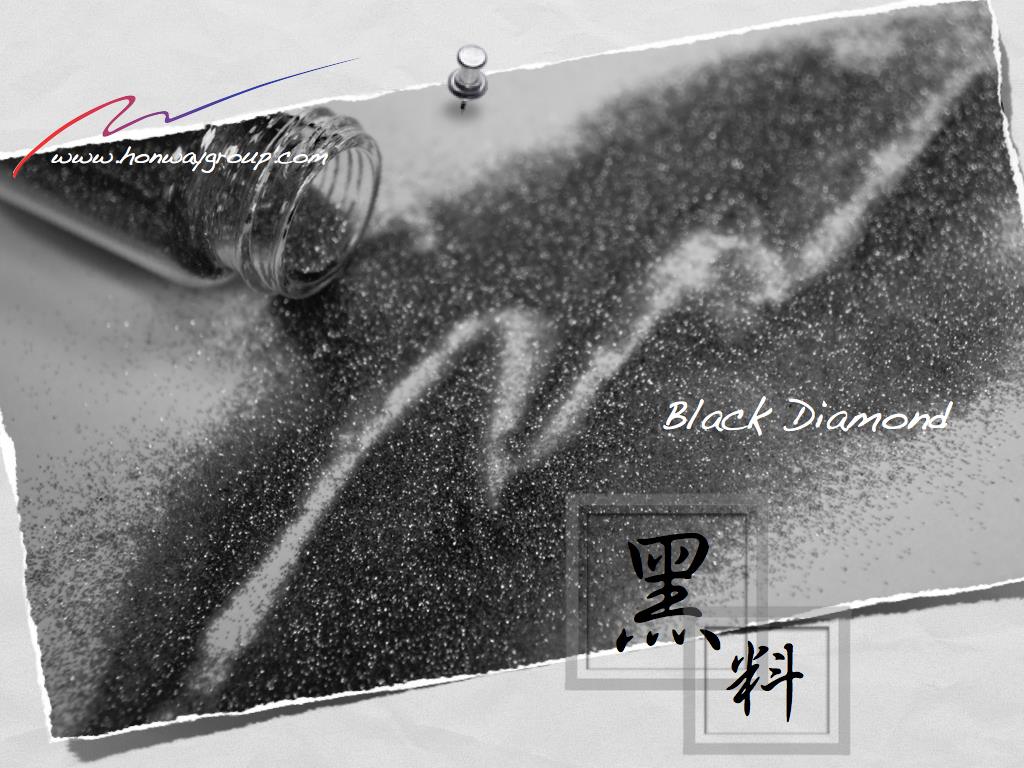Common climate action goals:
Carbon footprint: The total greenhouse gas emissions, both direct and indirect, produced during the lifecycle of an activity or product.
Carbon Footprint Verification (CFV): Companies or organizations inventory their carbon footprint, including Scope 1, Scope 2, and Scope 3 emissions.
Net-zero emissions: Achieving a net-zero state means that the total anthropogenic greenhouse gas emissions over a specific time period equal the total anthropogenic removal.
Carbon neutrality: “Carbon emissions” and “carbon removals” are equal, effectively canceling each other out—one positive and one negative.
Climate neutrality: Net-zero greenhouse gases are achieved by offsetting warming activities through reduction, removal, or cooling processes.
Carbon negative: Over a specific period, the amount of carbon dioxide removed exceeds the amount emitted.
Table of Contents
What is Net-zero Emissions?
To address global warming and the pressing climate crisis, the goals of carbon reduction and achieving net-zero emissions have become more critical than ever. One key to halting the Earth’s temperature rise is reducing global carbon emissions to 2005 levels by 2050.
In the discussion of sustainable development, “net-zero emissions” is undoubtedly one of the most prominent keywords. According to the Intergovernmental Panel on Climate Change (IPCC), net-zero emissions refer to the state where the total amount of human-induced greenhouse gas emissions, minus human-induced removals, equals zero over a specified period. In other words, net-zero does not mean completely ceasing emissions but rather minimizing human-induced emissions to the lowest possible level and offsetting the remaining emissions through carbon-negative technologies, forest carbon sinks, and similar measures.
What is Carbon Neutrality?
Carbon neutrality refers to the total carbon dioxide emissions generated directly or indirectly by a country, company, product, activity, or individual within a certain timeframe. These emissions are offset through the use of low-carbon energy to replace fossil fuels, afforestation, energy-saving measures, and emission reductions to balance the emitted carbon dioxide with the removed amount, achieving relative “zero emissions.” However, carbon neutrality is not the same as “carbon-free.” Carbon-free means that no greenhouse gases are emitted during production or manufacturing processes.
The Differences Between Net-zero, Carbon Neutrality, and Climate Neutrality
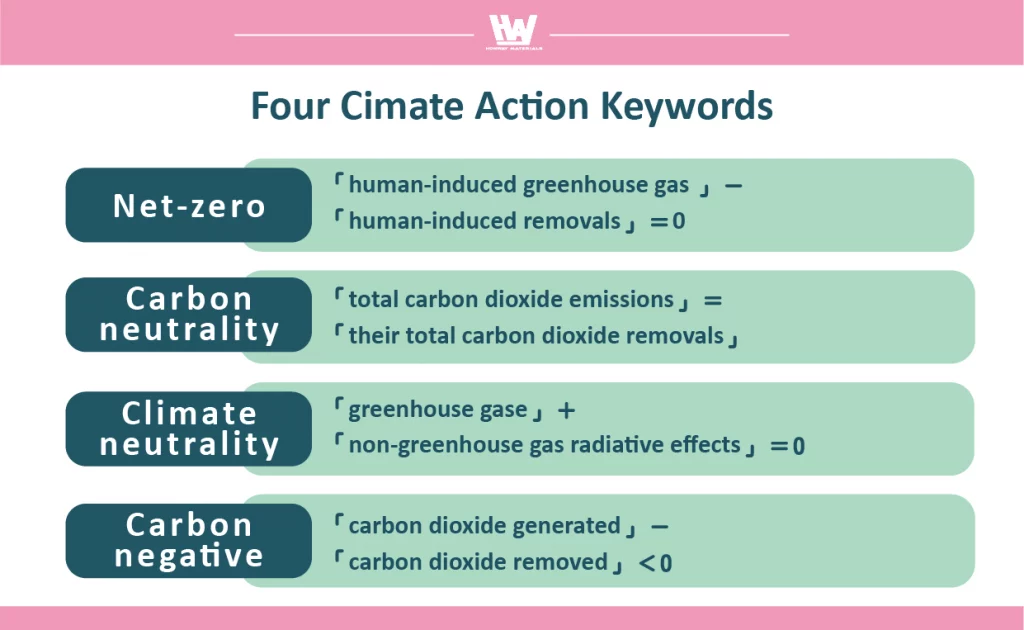
Net-zero emissions: Refers to the state where the global human-induced greenhouse gas emissions minus human-induced removals equal zero over a specific timeframe.
Carbon neutrality: Refers to a company’s or organization’s total carbon dioxide emissions equaling their total carbon dioxide removals within a specific period, canceling each other out to achieve carbon neutrality, which can also be referred to as net-zero carbon dioxide emissions.
Climate neutrality: Unlike “net-zero carbon” or “carbon neutrality,” climate neutrality encompasses not only greenhouse gases but also non-greenhouse gas radiative effects, such as the radiative forcing effect of aircraft contrails. This is achieved by offsetting any activity causing warming effects through reduction, removal, or cooling to achieve net-zero across all greenhouse gases.
Besides “net-zero emissions” and “carbon neutrality,” another commonly mentioned climate action goal is “carbon negative.”
Carbon negative: Refers to a state where, over a specified period, the amount of carbon dioxide removed exceeds the amount produced, leading to a negative balance, i.e., carbon dioxide generated” minus “carbon dioxide removed” equals a negative value.
Taiwan’s Strategies for Achieving Net-zero by 2050
The Paris Agreement is a landmark international treaty adopted at the 2015 United Nations Climate Change Conference (COP21). Its primary goal is to limit the global average temperature rise to within 2°C above pre-industrial levels, while striving to limit it to 1.5°C. To achieve this goal, “net-zero emissions” has been established as a core strategy. Currently, over 130 countries have declared their commitment to achieving net-zero carbon emissions by 2050.
In 2015, the United Nations introduced the Sustainable Development Goals (SDGs), encompassing 17 specific goals, with most targets expected to be achieved by 2030. Accordingly, highly efficient enterprises may reach net-zero carbon emissions by 2030, while slower-progressing ones might achieve this by 2050. In other words, net-zero carbon emissions will become a universal target that all businesses and organizations must strive to achieve in the future.
Taiwan’s Comprehensive Net-Zero Carbon Transition Plan
Taiwan has based its net-zero emission energy pathway on strategies outlined by the International Energy Agency (IEA), the United States, the European Union, and South Korea. The plan is divided into two phases:
Short-term Goal (Achieve Low Carbon by 2030): Implement feasible carbon reduction measures to minimize emissions from both energy use and non-energy use sources.
- Energy System: Drive energy transition by prioritizing mature wind and solar energy development, actively increase the supply of green energy. Meanwhile, invest in research and development of geothermal and ocean energy technologies, gradually reduce reliance on coal through increased use of natural gas.
Long-term Goal (Zero Carbon Development by 2050): Develop a long-term net-zero plan to ensure the timely implementation of emerging net-zero technologies while adjusting energy, industrial structures, and societal lifestyles.
- Energy System: Significantly expand renewable energy deployment, integrate natural gas facilities with Carbon Capture, Utilization, and Storage (CCUS) technologies, introduce hydrogen power generation, gradually building a zero-carbon power system, and transition coal-fired power plants into a backup role for strategic energy security.
- Maximize Electrification of Industrial Sectors and Household Appliances: Reduce carbon emissions from non-electricity sectors and concentrate efforts on increasing the proportion of zero-carbon energy in the power sector.
- Actively Invest in Technology Development: Focus on developing high-efficiency wind and solar power generation technologies, Carbon Capture, Utilization, and Storage (CCUS), and hydrogen power generation along with related technologies.
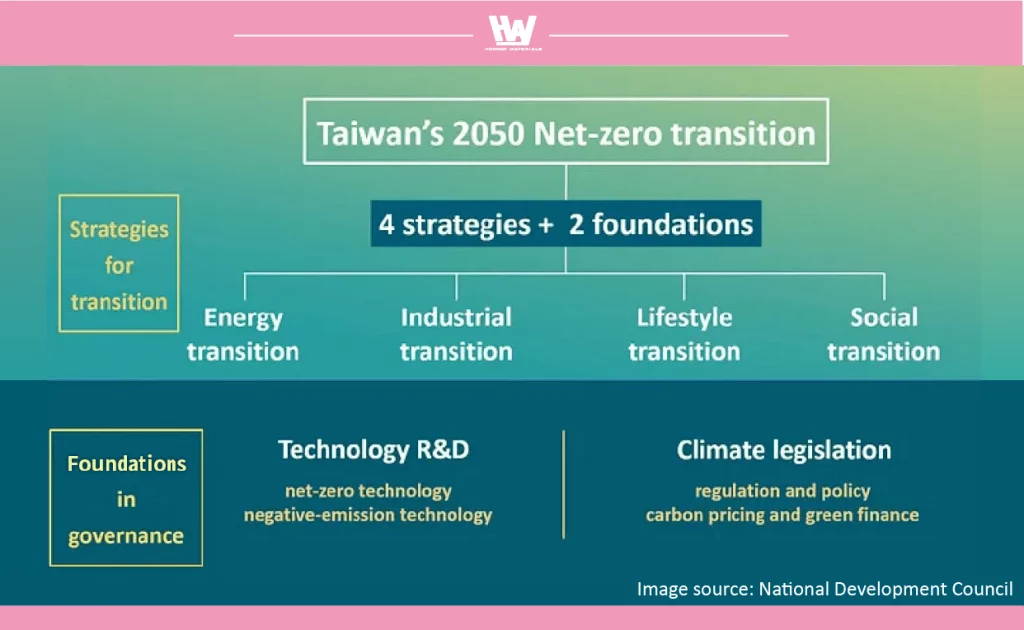
Two Foundations
Technological Research and Development: Prioritize the development of net-zero and negative emission technologies.
Climate Legislation: Establish legal frameworks, regulatory policies, carbon pricing, and green finance initiatives.
Four Strategies
Energy Transition: Focus on three key strategies, including “Building a zero-carbon energy system,” “Enhancing energy system resilience,” “Promoting green growth.”
Industrial Transition: Emphasize three core areas, including “Process improvement,” “Energy conversion,” “Circular economy,” to reduce industrial carbon emissions.
Lifestyle Transformation: Achieve consensus on “2050 Net-Zero Emissions” through public engagement. Promote a “use over ownership” lifestyle, foster zero-waste habits, adopt low-carbon dietary practices, encourage the development of net-zero circular buildings for both new and existing structures, and establish low-carbon shared transport networks alongside convenient public transit systems.
Social Transformation: Highlight governance mechanisms for “just transition” and “citizen participation.” Propose strategies to identify and mediate transformation conflicts, enhance conflict resolution mechanisms, and establish support systems and tools to collectively build societal resilience and facilitate a comprehensive transition.
Five Pathways
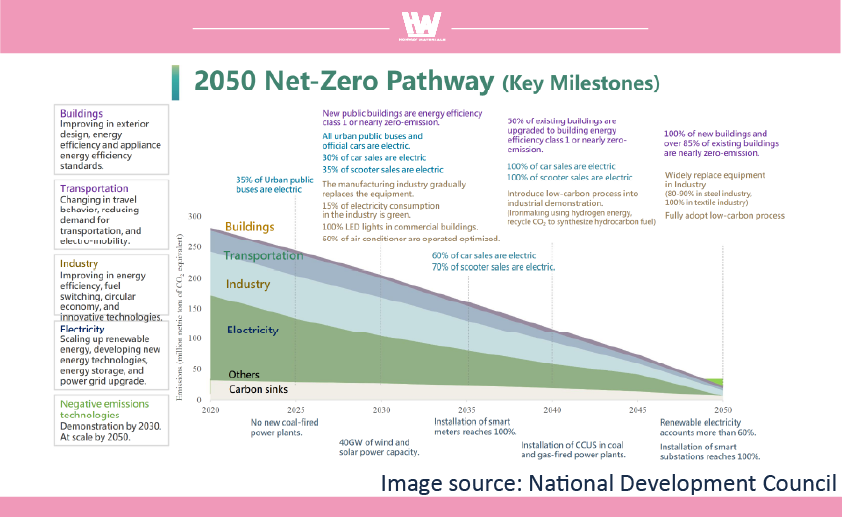
Buildings: Improve building envelope designs, enhance building energy efficiency, and set higher standards for household appliances.
Transportation: Change transportation models, reduce transport demand, and promote the electrification of vehicles.
Industry: Improve energy efficiency, advance fuel conversion, promote the circular economy, and innovate manufacturing processes.
Electricity: Expand renewable energy capacity, develop new energy technologies and energy storage systems, and upgrade grid infrastructure.
Negative Carbon Technologies: Plan to enter demonstration phases by 2030 and achieve widespread adoption by 2050.
Four Goals
Safer Energy Transition: Expand renewable energy installations to increase domestic energy production, reducing reliance on imported energy. Decrease the dependence on imported energy from 97.4% in 2021 to below 50% by 2050, mitigating risks from international energy market fluctuations and price volatility.
More Competitive Industrial Transition:
- Continue promoting green energy deployment to ensure an adequate supply of green electricity while driving the growth of green energy and domestic supply chains.
- Help industries meet supply chain and global green initiative requirements, leverage the advantages of the ICT sector to provide more efficient, lower-carbon, and smarter manufacturing processes.
- Plan for forward-looking technologies, accelerate commercialization of local advantageous technologies, and capitalize on global net-zero transition opportunities.
More Sustainable Lifestyle Transition: Increase public awareness and consensus on climate change and net-zero transition to inspire behavioral changes; Promote low-carbon lifestyles across food, clothing, housing, and transportation; Encourage businesses to adopt low-carbon business models, creating a green lifestyle industry chain.
More Resilient Social Transformation: Strengthen governance mechanisms for “just transition” and “citizen participation;” Implement systems to build societal support frameworks, ensuring resilience and fostering an inclusive and equitable transition.
12 Key Strategies for Achieving Net-Zero Emissions by 2025
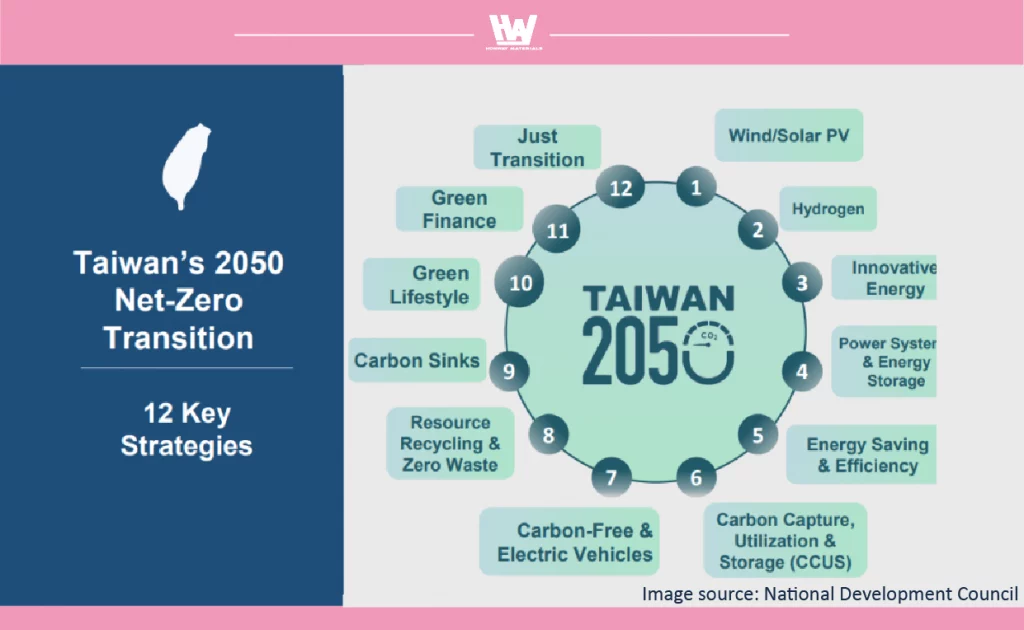
Wind and Solar Power: Prioritize wind and solar power as the primary renewable energy sources.
Hydrogen Energy: Position hydrogen energy as a core option for net-zero, utilizing it for zero-carbon industrial processes, transportation, and carbon-free power generation.
Forward-Looking Energy: Focus on geothermal and ocean energy as baseload power sources, expand the use of biomass energy, and plan to achieve an installed capacity of 8–14 GW by 2050.
Power Systems and Energy Storage: Develop distributed grids, strengthen grid resilience, and enhance grid adaptability through digitalization and operational flexibility.
Energy Efficiency: Expand the application of mature technologies to improve energy utilization efficiency while simultaneously developing innovative energy efficiency technologies and gradually introducing forward-looking technologies.
Carbon Capture, Utilization, and Storage (CCUS): Deploy CCUS technologies to remove carbon emissions from industrial and energy facilities, explore local carbon storage sites, and launch safety validation pilot projects.
Electrification and Decarbonization of Vehicles: Develop the upstream and downstream industries of electric vehicles, integrate infrastructure technologies such as energy storage, charging stations, and building charging safety systems.
Zero-Waste Resource Recycling: Enhance waste reduction at the product design stage, promote green design and green consumption, and advance waste resource reuse to create a zero-waste, sustainable circular economy.
Natural Carbon Sinks: Implement afforestation and related management efforts to reduce atmospheric carbon dioxide concentrations, develop carbon-negative farming practices, and conserve ocean habitats, biodiversity, and ecosystems.
Net-Zero Green Living: Promote “net-zero green living” through shared business models, sustainable consumption patterns, and fostering public consensus via nationwide dialogues, aiming to cultivate a sustainable and low-carbon lifestyle.
Green Finance: Leverage financial markets to encourage enterprises to prioritize net-zero transition and climate change adaptation by directing investments toward green and sustainable development sectors.
Just Transition: Strive to “leave no one behind” by ensuring balanced policy objectives, equitable social distribution, and inclusive stakeholder engagement throughout the net-zero transition process.
The Ten Key Industries to Achieving Net-zero
Overviewing Taiwan’s 2050 Net-zero pathway and strategies, there are three major sectors comprising ten key industries targeted for priority transformation: manufacturing, commercial, and energy sectors, with tailored net-zero strategies for each industry.
Manufacturing Sector: Includes petrochemicals, electronics, cement, paper, steel, and textiles industries.
Commercial Sector: Includes retail, food services, and logistics industries.
Energy Sector: Focuses on energy industries, with short-term efforts led by state-owned enterprises such as China Steel Corporation and CPC Corporation.
※ Steel Industry Example – Most Relevant to Honway:
Process Improvement: In the short term, focus on improving energy efficiency by introducing energy-saving equipment, upgrading outdated facilities, and developing smart blast furnaces. In the long term, align with international trends to develop hydrogen injection into blast furnaces and hydrogen-based direct reduction ironmaking technology.
Energy Transition: All boilers in the steel industry currently operate on natural gas. Future efforts will involve installing solar panels and increasing the share of green energy usage by purchasing renewable electricity and certificates.
Circular Economy: In the short term, prioritize increased use of scrap steel to reduce the consumption of raw materials. In the long term, adopt Carbon Capture and Utilization (CCU) technologies, focusing on integrated steel-chemical production. This involves collaborating with domestic petrochemical companies to recycle carbon dioxide into chemical products.
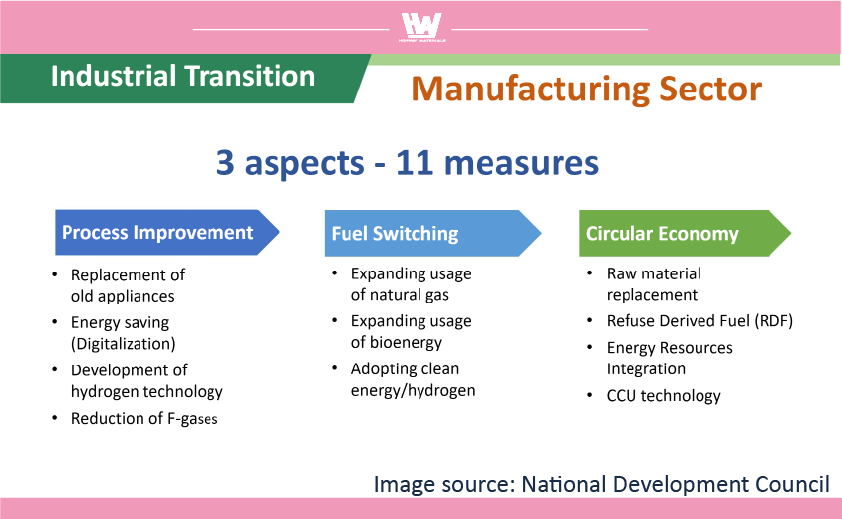
Three Focus Areas and 11 Measures for the Industry Sector: The transformation will follow a “large-first, small-later” approach, starting with large enterprises and gradually involving small and medium enterprises (SMEs). Large enterprises will act as role models, with state-owned companies taking the lead in implementation. Additionally, industry associations and supply chain hub factories will help SMEs build carbon inventory and reduction capabilities. This collaborative effort will drive upstream and downstream suppliers to adopt green procurement and green production, forming a green supply chain and enhancing Taiwan’s competitiveness in net-zero transformation.
Conclusion
Taiwan’s Commitment to 2050 Net-Zero Emissions and Carbon Neutrality: Taiwan aims to reduce greenhouse gas emissions and enhance carbon removal capabilities through energy transition, carbon capture technologies, and forestry carbon sinks. The collective efforts of the government, businesses, and citizens are essential to achieving this goal. Despite significant challenges, Taiwan is poised to play a vital role in global sustainable development through policy guidance, technological innovation, and international cooperation, achieving a win-win for the economy and the environment.
Honway focuses on physical polishing technologies and has rich experience in super-hard abrasives and rare-earth raw materials, dedicated to providing low-pollution polishing solutions to meet customers’ needs for environmental sustainability and high performance.
Action
- Learn what ESG is at once>>>What is ESG? What Benefit can ESG Bring to Companies? How to Implement ESG?
- Mandatory Carbon Inventory for Large Enterprises>>>What is Carbon Footprint Verification? Understanding the 5 Steps for Verification to Grasp the Future of Carbon Reduction
- Policy Perspective>>Many countries have announced and begun implementing action plans for “2050 net-zero emissions.”
- Evaluate whether the current manufacturing processes meet carbon reduction objectives.
- Assess if the existing polishing processes could be replaced with more carbon-efficient alternatives.
- How to implement
- Implement testing and review
Sources: Taiwan’s 2050 Net-Zero Pathway and Strategies Overview
National Development Council (NDC): https://www.ndc.gov.tw/
Environmental Protection Administration (EPA).
Honway specializes in physical polishing, ultra-hard abrasives, and rare-earth materials, striving to provide polishing solutions with reduced environmental impact. If you have related needs or would like to learn more, please feel free to contact us! Let’s work together toward a sustainable future.
Customized Grinding Solutions: We offer tailored adjustments to our grinding processes, allowing us to meet specific processing needs for maximum efficiency.
After reading the content, if you still don’t know how to select the most suitable option,
Feel free to contact us and we will have specialist available to answer your questions.
If you need customized quotations, you’re also welcome to contact us.
Customer Service Hours: Monday to Friday 09:00~18:00 (GMT+8)
Phone: +8867 223 1058
If you have any topics you want to learn more about or if you find it difficult to explain over the phone, feel free to message us on Facebook.
Honway Facebook: https://www.facebook.com/honwaygroup

